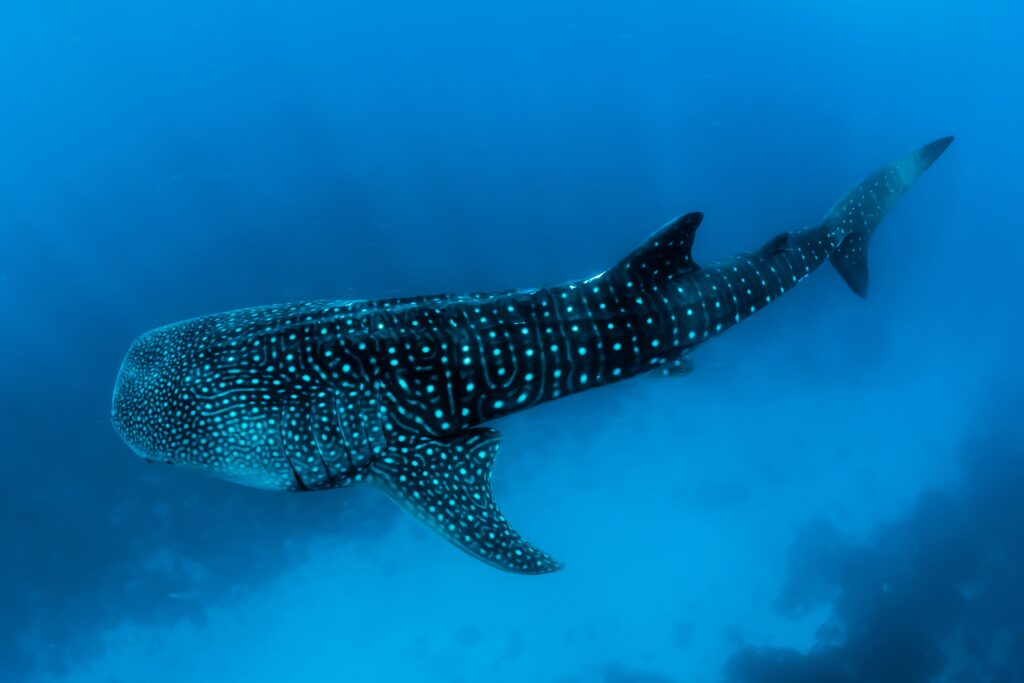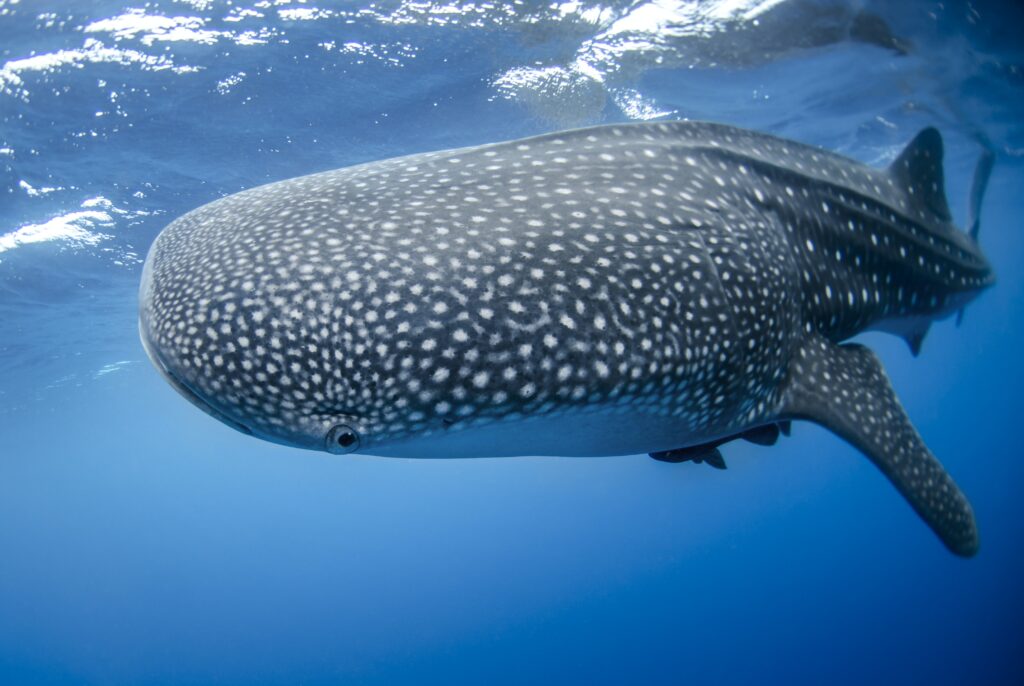Have you ever wondered how deep you would need to go in the ocean to come face-to-face with a shark? In this article, we will explore the depths at which you are most likely to encounter these fascinating creatures. From the shallows to the abyss, we will delve into the different species of sharks and their preferred habitats. Join us as we navigate the various layers of the ocean to uncover where these majestic predators lurk.

The Depth Range of Sharks
If you’ve ever wondered how deep you have to go to find sharks, you’ll be fascinated to learn about the depth range of these incredible creatures. Sharks can be found in a variety of habitats and depths, ranging from shallow waters to the extreme depths of the ocean. In this article, we’ll explore the distribution patterns, behavior, and preferences of sharks at different depths, as well as techniques used to study them. So, let’s dive in and discover the hidden world of sharks!
Shark Habitat and Distribution
Sharks are known to inhabit oceans all over the world, from the frigid waters of the Arctic to the tropical reefs of the Pacific. They have an extraordinary ability to adapt to different environments, allowing them to thrive in a wide range of habitats. From the coastal shallows to the vast expanses of the deep sea, sharks can be found in almost every corner of the ocean.
Shallow Water Shark Species
Many species of sharks are commonly found in shallow water habitats, such as coastal areas, estuaries, and coral reefs. These shallow water shark species include popular favorites like the great white shark, tiger shark, and bull shark. These sharks are often encountered by beachgoers and divers, making them well-known and highly researched.
Deep Sea Shark Species
As you venture deeper into the ocean, you’ll encounter a whole different set of shark species adapted to the extreme conditions of the deep sea. These deep-sea sharks have unique characteristics that allow them to survive in the darkness and crushing pressures found at great depths. Some examples of deep sea shark species include the lanternshark, gulper shark, and cookiecutter shark.
Shark Distribution Patterns
The global distribution of sharks is not evenly spread throughout the oceans. There are distinct patterns in the distribution of different shark species, influenced by various factors such as temperature, food availability, and ocean currents. Let’s explore some of these distribution patterns and how they vary across different oceans.
Global Distribution of Sharks
While sharks can be found in almost every ocean, certain regions are known to have a higher diversity and abundance of shark species. The reefs of the Indo-Pacific, including the Coral Triangle, are considered hotspots for shark biodiversity. Other areas, such as the Western Atlantic and the Mediterranean Sea, also harbor a significant number of shark species.
Shark Species Distribution in Different Oceans
Each ocean has its own unique set of shark species, adapted to the specific conditions of their respective habitats. The Atlantic Ocean is home to a wide range of shark species, including the hammerhead shark, lemon shark, and blue shark. In the Pacific Ocean, you’ll find iconic species like the great white shark, mako shark, and whale shark. The Indian Ocean is known for its abundance of reef shark species, such as the blacktip reef shark and whitetip reef shark.
Factors Affecting Shark Distribution
Several factors influence the distribution of sharks in the ocean. Temperature is a crucial factor, as sharks are ectothermic creatures, meaning their body temperature is regulated by the surrounding water. Most sharks prefer temperate or tropical waters, but some species, like the Greenland shark, can tolerate colder temperatures. Food availability also plays a role, with sharks being more abundant in areas with a high concentration of prey. Ocean currents and water depth can also impact shark distribution, as these factors affect the availability of both food and suitable habitats.
Shark Behavior and Migration
Understanding shark behavior and migration patterns is essential in unraveling the mysteries of their depth preferences. While some sharks are sedentary and stay in one area throughout the year, others engage in long-distance migrations. Let’s explore these fascinating aspects of shark behavior and how they relate to their depth preferences.
Shark Migration Patterns
Many shark species undertake seasonal migrations, moving between different habitats to take advantage of varying food availability and reproductive opportunities. For example, the great white shark is known to undertake long-distance migrations, traveling thousands of miles to reach feeding grounds. Whale sharks also migrate long distances in search of plankton-rich areas. These migrations can take sharks into deeper waters as they follow their preferred prey.
Seasonal Variations in Shark Movements
Shark movement patterns can vary throughout the year, with seasonal variations affecting their behavior. In certain seasons, sharks may become more concentrated in certain areas, such as during spawning events or when specific prey species are abundant. As a result, the depth range in which sharks can be found may change throughout the year, depending on these seasonal dynamics.
Reproductive Migration of Sharks
Many sharks undertake reproductive migrations, moving to specific areas to mate and give birth. Female sharks often travel to shallow, protected habitats like coastal bays or estuaries to give birth to their young. This behavior ensures the safety of their offspring during the vulnerable early stages of life. After giving birth, the female sharks may return to deeper waters, while the juveniles may remain in the shallow areas until they are ready to venture into deeper depths.
Depth Preferences of Sharks
Sharks exhibit a wide range of depth preferences, with different species adapted to thrive in specific depth ranges. This allows the ocean to be inhabited by sharks across multiple layers of the water column, from the shallows to the extreme depths. Let’s take a closer look at the depth preferences of different shark species.
Shark Species with Preference for Shallow Waters
Many shark species are commonly associated with shallow waters, including coastal areas and coral reefs. These sharks are often encountered by beachgoers and divers, making them some of the most well-known and iconic species. Some examples of shallow water shark species include the nurse shark, blacktip shark, and lemon shark. These sharks are typically found in depths ranging from a few meters to a few hundred meters.
Shark Species Found in Mid-Water Depths
Mid-water sharks, also known as pelagic sharks, inhabit the open ocean away from the coastlines. These species are capable of living at various depths, from the surface to several hundred meters down. Examples of mid-water shark species include the blue shark, thresher shark, and silky shark. These sharks are often highly migratory, covering long distances in search of food and suitable habitats.
Deep Sea Shark Species
As you descend into the depths of the ocean, you’ll encounter an incredible array of deep-sea shark species. These sharks have evolved to survive in the extreme conditions of the deep sea, where sunlight cannot penetrate and pressures are immense. Some of the deep sea shark species include the goblin shark, frilled shark, and sixgill shark. These sharks are often found at depths exceeding 1,000 meters, with some species even venturing into the abyssal zone, which reaches depths of 4,000 meters or more.

Techniques to Study Sharks at Different Depths
Studying sharks at different depths is a challenging task, given the inhospitable nature of their habitats. However, scientists have developed various techniques to overcome these challenges and gain insights into the lives of sharks. Let’s explore some of these techniques used to study sharks at different depths.
Shark Tagging and Tracking Methods
One of the most common techniques used to study shark behavior is tagging and tracking. Researchers attach small electronic tags, known as satellite tags or acoustic tags, to the sharks. These tags transmit data about the sharks’ location, depth, and temperature to researchers, providing valuable information about their movements and behavior. This technique has allowed scientists to track the movements of sharks across different depths and gain insights into their preferred habitats and migration patterns.
Underwater Remotely Operated Vehicles (ROVs)
Underwater Remotely Operated Vehicles (ROVs) are unmanned submersible vehicles equipped with cameras and sensors that allow scientists to explore the depths of the ocean. These ROVs are controlled remotely from the surface and can descend to great depths, capturing high-resolution images and videos of the deep-sea environment. By deploying ROVs, researchers can observe deep-sea shark species in their natural habitat, providing valuable information about their behavior and habitat preferences.
Deep Sea Submersibles
For exploring the extreme depths of the ocean, scientists rely on deep sea submersibles. These manned vehicles are designed to withstand the immense pressures of the deep sea and allow researchers to directly observe and collect samples from the deep-sea environment. By using deep-sea submersibles, scientists have been able to discover and study previously unknown deep-sea shark species. These expeditions provide invaluable information about the depths at which certain sharks can be found and shed light on the hidden mysteries of the deep sea.
Extreme Deep Sea Shark Species
The deep sea is home to some of the most fascinating and bizarre shark species. These extreme deep-sea sharks have unique adaptations that allow them to survive in the harsh conditions of the abyss. Let’s take a look at a few of these extraordinary deep-sea sharks.
The Goblin Shark
The goblin shark is often referred to as a living fossil due to its unique appearance and ancient lineage. This species is known for its elongated snout, protruding jaws, and sharp teeth. It resides in the depths of the ocean, typically at depths between 200 and 1,300 meters. The goblin shark’s pinkish color is also noteworthy, as it helps it blend in with the darkness of the deep sea.
The Frilled Shark
The frilled shark is another deep-sea dweller with a peculiar appearance. It has a long, eel-like body and a mouth full of needle-like teeth. This species is often found in the depths of the Atlantic and Pacific Oceans, typically between 100 and 1,500 meters deep. The frilled shark is believed to be an ambush predator, using its unique jaw structure to capture its prey with lightning-fast strikes.
The Sixgill Shark
The sixgill shark, also known as the cow shark, is the largest known deep-sea shark species. It can reach lengths of up to 16 feet and inhabit depths of up to 2,500 meters. Despite its formidable size, this shark is rarely encountered by humans due to its preferred deep-sea habitat. The sixgill shark has unique physiological adaptations that allow it to thrive in the cold and dark conditions of the deep sea.

Unexplored Ocean Depths and Potential Shark Discoveries
While we have made significant progress in understanding sharks, there are still vast areas of the ocean that remain unexplored. The deep-sea trenches, particularly the Hadal Zone, present immense challenges for researchers due to their extreme depths and harsh conditions. However, venturing into these uncharted depths holds the potential for exciting new discoveries, including new shark species. Let’s explore the unexplored ocean depths and the efforts being made to uncover the secrets they hold.
The Hadal Zone
The Hadal Zone is the deepest part of the ocean, found in the deep-sea trenches. These trenches reach depths of 6,000 to 11,000 meters and are among the most extreme environments on Earth. Scientists have only recently begun to explore these depths, using cutting-edge technology to study the unique ecosystem that thrives there. While our knowledge of sharks in the Hadal Zone is limited, it is likely that there are undiscovered shark species lurking in these mysterious depths.
Extreme Deep Sea Ecosystems
Beyond the trenches, the deep sea is teeming with unique and diverse ecosystems. Cold seeps, hydrothermal vents, and underwater mountains are just a few examples of the extreme habitats that exist in the deep sea. These ecosystems provide shelter and food for a wide variety of deep-sea species, including sharks. By studying these extreme deep-sea ecosystems, scientists hope to uncover new insights into the lives of deep-sea sharks and their depth preferences.
Future Exploration Efforts
Exploring the depths of the ocean is a challenging endeavor, but advancements in technology and scientific understanding are making it increasingly possible. Future exploration efforts will likely focus on developing more advanced submersible vehicles and deep-sea sampling techniques. These efforts hold the promise of discovering new shark species and expanding our understanding of the mysterious depths of the ocean.
Shark Conservation and Deep Sea Protection
Shark populations worldwide face numerous threats, including overfishing, habitat loss, and climate change. Protecting these magnificent creatures, along with their deep-sea habitats, is crucial for their survival and the health of the oceans. Let’s explore the importance of shark conservation and the efforts being made to protect the deep sea.
Impact of Human Activities on Sharks
Human activities, particularly overfishing, pose a significant threat to shark populations. Sharks are often targeted for their fins, which are considered a delicacy in some cultures. This practice, known as shark finning, has led to the decline of many shark species. Additionally, habitat destruction, pollution, and climate change further exacerbate the challenges faced by sharks. Conserving sharks and their habitats is essential for maintaining the delicate balance of ocean ecosystems.
Deep Sea Marine Protected Areas
Establishing marine protected areas (MPAs) is a crucial step in safeguarding the deep sea and its inhabitants, including sharks. MPAs provide a safe haven for marine species and help to preserve biodiversity. These protected areas restrict fishing activities and other harmful human impacts, allowing sharks and other deep-sea species to thrive. By designating more MPAs in the deep sea, we can create refuges for sharks and contribute to their conservation.
Conservation Initiatives
Numerous organizations and initiatives are dedicated to shark conservation and the protection of the deep sea. These organizations work tirelessly to raise awareness about the importance of sharks, advocate for sustainable fishing practices, and promote the establishment of marine protected areas. Additionally, public support and community involvement play a crucial role in the success of conservation efforts. By supporting these initiatives, we can contribute to the conservation of sharks and the preservation of their deep-sea habitats.

Shark Interaction with Submerged Structures
In addition to their natural habitats, sharks are known to interact with artificial structures, such as submerged reefs, shipwrecks, and oil rigs. These structures provide unique opportunities for shark encounters and attract a wide variety of species. Let’s explore some examples of shark interaction with submerged structures.
Sharks Around Artificial Reefs
Artificial reefs, created by sinking decommissioned ships or structures, provide a habitat for a wide range of marine species, including sharks. These submerged structures attract sharks due to the abundance of shelter and food they provide. Divers and snorkelers often visit these artificial reefs to observe the sharks that congregate around them, making them popular tourist destinations. By interacting with sharks in these controlled environments, people can gain a deeper appreciation for these magnificent creatures and the importance of their habitats.
Shark Species Associated with Shipwrecks
Shipwrecks have long been known to attract sharks, as they provide shelter and serve as feeding grounds. Sharks are drawn to the scent of decaying organic matter and the presence of potential prey that can be found around shipwrecks. Species like the bull shark and lemon shark are particularly known for their association with shipwrecks. The submerged wreckage creates an ecosystem that supports a diverse array of marine life, making shipwrecks not only fascinating historical sites but also important habitats for sharks.
Oil Rigs and Shark Attraction
Oil rigs, like shipwrecks, also attract sharks and other marine species. These massive structures create artificial reefs that provide shelter and a rich food source. Sharks are known to congregate around oil rigs due to the abundance of smaller fish and other marine life that are attracted to the structure. While the presence of sharks around oil rigs may raise concerns for some, it also presents an opportunity for researchers to study shark behavior and gain insights into their interaction with these unique artificial habitats.
Conclusion
So, how deep do you have to go to find sharks? As we have explored, sharks can be found in a wide range of depths, from the shallow coastal waters to the extreme depths of the ocean. The distribution, behavior, and preferences of sharks at different depths are influenced by various factors such as temperature, food availability, and ocean currents. By studying sharks at different depths and protecting their habitats, we can unlock the secrets of these magnificent creatures and ensure their survival for future generations to come. So, the next time you venture into the ocean, remember that beneath the surface lies a world full of wonders, including the depths where sharks roam.

- Can You Dive With Sharks In California? - August 19, 2023
- What Are The Rules Of Shark Cage Diving? - August 19, 2023
- Where In Florida Can You Dive With Sharks? - August 19, 2023








